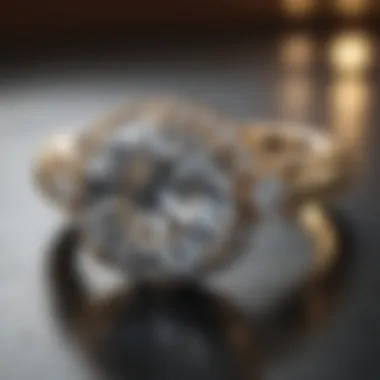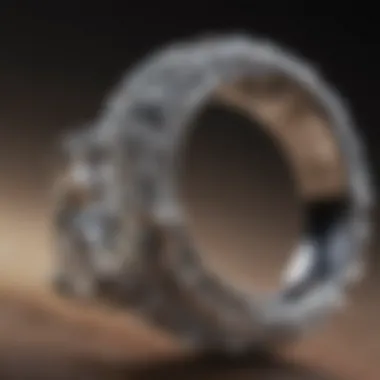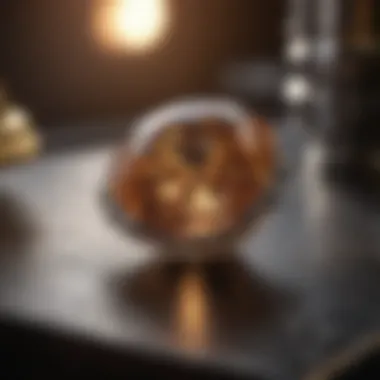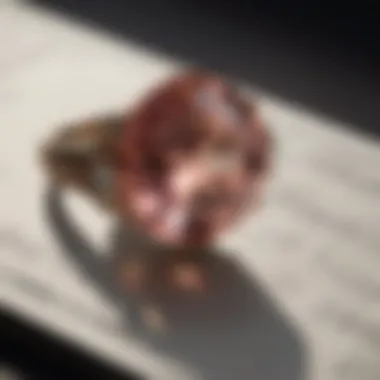How to Identify a Genuine Diamond Ring


Intro
When acquiring a diamond ring, understanding its authenticity is vital for both emotional and financial purposes. Diamonds have long represented love, commitment, and status. However, the market is flooded with imitations and simulants. Distinguishing a real diamond from a fake one is therefore crucial for gem enthusiasts, collectors, and anyone investing in jewelry. This guide will delve into various ways to identify a genuine diamond ring and provide insights that can empower the reader in their purchasing decisions.
Gemstone Overview
Definition and Origins
Diamonds are a form of carbon crystallized under intense heat and pressure deep within the Earth's mantle. Their carbon structure gives them unique optical properties, making them prized for their brilliant light reflection and exceptional hardness. Historically, diamonds were believed to possess magical and healing properties. Their rarity and beauty have also led to a rich cultural history intertwined with notions of wealth and romance.
Historical Significance
The allure of diamonds is well-documented throughout history. Ancient civilizations revered them as symbols of power and status. In India, they were first mined and traded over 2,000 years ago, while European nobility adopted diamonds in royal crowns and jewelry. The 20th century saw diamonds become a widespread symbol of engagement and commitment, largely influenced by marketing campaigns. Understanding this history enriches the significance of owning a diamond ring today.
Gemstone Properties
Hardness and Durability
One of the most impressive characteristics of diamonds is their hardness. On the Mohs scale, diamonds score a perfect 10, making them the hardest natural material on the planet. This property ensures that diamonds resist scratching and wear, maintaining their beauty over time. Buyers should understand that this durability is a key aspect of the diamond's value.
Color and Clarity
Color and clarity are essential parameters to assess when evaluating the quality of a diamond. Real diamonds exhibit a range of colors, with clear or near-colorless stones being the most sought after. The Gemological Institute of America uses a grading scale to classify diamond color from D (colorless) to Z (light yellow or brown).
Clarity refers to the presence of internal or external flaws, known as inclusions and blemishes, respectively. While some imperfections are natural and do not significantly affect the appearance, they can impact the diamond's value. Thus, potential buyers should familiarize themselves with the grading system, as it provides insights into the authenticity and worth of the diamond.
"The beauty of a diamond lies not only in its sparkle but also in its unique characteristics."
Additionally, understanding the cut of the diamond affects its appearance. The quality of the cut influences how light reflects off the diamond’s facets, enhancing its brilliance. A well-cut diamond will sparkle more, making it appear more valuable.
Prologue
When it comes to purchasing a diamond ring, the stakes are high. Understanding whether a diamond is genuine or a simularnt influences both financial investment and sentimental value. In this article, we explore various methods to assess the authenticity of diamond rings. This exploration is critical for ensuring that your purchase reflects its true value and quality. Not only does this enhance your knowledge, but it also empowers you to make informed decisions when investing in gems.
Understanding Diamonds
Diamonds are not merely stones; they are a manifestation of geological processes that compress carbon into crystal. This formation results in unique characteristics that define each diamond's value. Natural diamonds, formed over billions of years, possess specific features that a trained eye can recognize. The four Cs—carat, cut, color, and clarity—are essential when evaluating a diamond's quality. Each aspect influences its overall appearance and market value. Understanding these characteristics paves the way for effective analysis.
The Importance of Verification
Verification is integral for both buyers and sellers in the diamond market. Authentic diamonds carry a higher resale value than simulants, making it crucial for stakeholders to determine what they are purchasing. Moreover, in an age where synthetic diamonds are becoming increasingly accessible, recognizing the original article becomes vital. A reliable assessment gives buyers confidence in their investment. Additionally, reputable sellers often provide certification, which serves as a formal acknowledgment of authenticity. An appreciation of verification methods ultimately ensures you can distinguish between genuine diamonds and imposters.
Visual Inspection Techniques
The visual inspection techniques are essential tools in the process of determining the authenticity of a diamond ring. These methods allow individuals to assess specific characteristics such as clarity, color, and inclusiveness through direct observation. By using these techniques, one can often detect clues that may indicate whether a diamond is genuine or a simulant. Furthermore, these visual methods provide an immediate assessment that can help narrow down options before considering more complex testing.
Observing Clarity and Cut
Clarity refers to the presence of internal or external flaws in a diamond. A genuine diamond usually possesses a clarity grade that ranges from flawless to included. During inspection, one can check for any visible inclusions or blemishes using the naked eye. The cut of the diamond affects its light performance and can also provide necessary clues. A well-cut diamond will exhibit brilliance and a balanced proportions.
Here are key points to remember:


- A high-quality diamond will show only minor inclusions under magnification.
- The cut should enhance the stone's ability to reflect light.
To perform this observation, hold the ring in natural light and examine the stone from different angles. An authentic diamond may reflect light in a brilliant way that imitation stones cannot replicate.
Analyzing Color Grade
The color grade of a diamond plays a significant role in its overall value and authenticity. Genuine diamonds are typically colorless or near-colorless, while lower-quality stones may exhibit noticeable yellow or brown tones. To analyze this, observe the diamond against a white background. Check how the color appears under daylight versus artificial light sources.
- Colorless diamonds, rated D to F, are the most valuable.
- Diamonds rated G to J are near-colorless, often appearing white through casual observation.
An important detail is that many simulants will display a more pronounced color, which is often a dead giveaway.
Identifying Inclusiveness
Inclusions are tiny imperfections within a diamond and can act as fingerprints for the stone. Identifying these details can separate a real diamond from a simulant. Authentic diamonds tend to have unique inclusions that are natural, while simulants often lack these or may exhibit more uniform characteristics.
During inspection, look for:
- Crystal-like inclusions or tiny spots that indicate natural growth patterns.
- Bubbles or swirls, commonly found in simulants like glass or resin.
Using a jeweler's loupe can help magnify these features, making it easier to spot inclusions. Keep in mind that every diamond is unique, so understanding inclusiveness can provide valuable insight into authenticity.
The visual inspection techniques are the first line of defense in discerning the authenticity of diamond rings. They enable immediate assessments that can guide further evaluations.
Optical Tests for Authenticity
Optical tests play a critical role in determining the authenticity of a diamond ring. These methods leverage the unique optical properties of diamonds, enabling anyone to discern between real diamonds and simulants. Understanding these tests helps establish confidence in one’s purchase, saving time and potential regret. This section outlines the significance of optical tests while exploring practical ways to conduct them efficiently.
The Fog Test
The fog test is a straightforward method to assess a diamond's authenticity. To perform this test, gently breathe on the stone, creating a foggy mist. If the mist dissipates quickly, the diamond is likely real. Diamonds disperse heat well, meaning that they don’t retain moisture for long. In contrast, simulants like cubic zirconia retain the fog longer. This test is simple but effective, and it can be done anywhere.
The Water Test
Another practical test is the water test. This test requires a glass of water and the diamond to be examined. Drop the diamond into the water. If the diamond sinks, it is typically real. Real diamonds have a high density and will often sink quickly. However, if it floats or suspends in the water, it may indicate that it's a simulant. This method is not foolproof, but it can be a helpful initial assessment that can quickly clarify details.
Using a Loupe
Using a loupe is essential for a deeper examination of a diamond. This tool allows for a close-up view of the stone’s facets and inclusions. By looking through the loupe, one can identify specific characteristics that define authentic diamonds, such as unique internal imperfections or inclusions. Real diamonds often display the "feather" effect, which is a sign of natural formation. However, simulants usually have bubbles or distortions. Using a loupe can reveal these differences, making it a vital step in the assessment process.
Physical Tests and Their Implications
Physical tests provide pivotal insights into the authenticity of a diamond ring. These methods delve deeper than mere visual and optical examinations, offering tangible ways to evaluate a diamond's genuineness. Engaging in these tests allows gem enthusiasts and potential buyers to acquire a more profound understanding of their jewelry. While no single test can definitively conclude whether a diamond is real or not, combining various approaches enhances overall confidence in the assessment.
Two prominent tests in this category are the conductive test and the scratch test. By applying these tests, individuals can gauge the integrity and properties of their diamonds.
Conductive Test
The conductive test assesses a diamond's thermal conductivity—a critical property that distinguishes it from its simulants. Real diamonds possess a unique ability to disperse heat rapidly compared to imitation stones like cubic zirconia. To conduct this test, a thermal conductivity meter is necessary. This device can be acquired at jewelry supply shops or online marketplaces.
When using the meter, place the tip on the stone's surface. If the reading indicates high thermal conductivity, it is likely a genuine diamond. Conversely, low readings may suggest a simulant.
Benefits of the conductive test include:


- Quick assessment of thermal properties.
- Minimal risk of damaging the stone.
"A diamond’s unique thermal conductivity is one of its defining characteristics. Testing this property can significantly aid in authenticating the gem."
Scratch Test
The scratch test capitalizes on the fact that diamonds are the hardest known natural material. They can scratch almost all substances, making them an excellent tool for comparing hardness levels. In this test, a sharp object like a metal blade or a set of household items can help you determine the ring's authenticity.
To perform this test:
- Select a discreet area on the diamond's surface to avoid visible damage.
- Lightly attempt to scratch the diamond with the sharp object.
- If the diamond remains unscathed, it's likely genuine. If it scratches, you may be dealing with a simulant.
Considerations for the scratch test:
- It can damage softer materials, so caution is essential.
- Results can vary based on the pressure applied and angle of the approach.
- This test is not recommended for valuable or irreplaceable pieces.
Understanding Diamond Simulants
Understanding diamond simulants is crucial for anyone who wishes to navigate the complex world of diamond rings. Simulants can easily be mistaken for genuine diamonds, leading to confusion among buyers. The knowledge of these simulants allows individuals to make informed decisions and avoids costly mistakes. When choosing a diamond ring, distinguishing between a real diamond and its simulants plays a significant role in the purchase process.
One of the primary benefits of grasping the concept of diamond simulants is the financial aspect. Genuine diamonds can demand high prices due to their rarity and value. Simulants, on the other hand, offer similar visual appeal at a fraction of the cost. This fact can attract buyers who may want the look of a diamond without the financial burden of purchasing an actual stone.
However, there are important considerations to keep in mind when it comes to simulants. While they may resemble diamonds, their physical properties can vary significantly. This can affect factors like durability, brilliance, and overall performance in jewelry. Thus, understanding these differences equips the buyer with discernment and awareness, leading to more satisfying purchases in the long term.
Cubic Zirconia vs. Diamond
Cubic Zirconia (CZ) is one of the most popular diamond simulants. It is a synthetic stone that imitates many of the characteristics of a diamond, making it attractive for those who want an affordable alternative. In terms of appearance, CZ can have a sparkle similar to diamonds, but it lacks the unique fire and brilliance that genuine diamonds offer. Moreover, CZ has a lower hardness rating on the Mohs scale, measuring only 8-8.5 compared to diamonds, which measure 10. This difference in hardness leads to a higher likelihood of scratching over time.
When comparing the two, distinctive aspects arise:
- Cost: Cubic Zirconia is considerably more affordable, typically costing a fraction of the price of a diamond.
- Weight: CZ is denser than diamonds, making it heavier; this difference can often be perceived by holding both stones.
- Heat Resistance: Diamonds are more heat-resistant than CZ, which reacts differently to high temperatures.
These are fundamental aspects to know when evaluating a diamond ring because while CZ is visually pleasing, it does not carry the same intrinsic value as a true diamond.
Moissanite Comparison
Moissanite presents another noteworthy alternative to diamonds. While cubic zirconia is strictly synthetic, moissanite is a naturally occurring mineral, although commercial versions are lab-created. The appearance of moissanite is often confused with that of diamonds due to its high refractive index, which results in a stunning sparkle that can outshine a diamond.
Key factors to consider between moissanite and diamonds include:
- Brilliance: Moissanite refracts light more effectively, creating a different sparkle. It can appear more colorful and vibrant under certain conditions.
- Hardness: Measuring 9.25 on the Mohs scale, moissanite is robust but still not as hard as diamonds. This means it can scratch, although less frequently than CZ.
- Price: Moissanite tends to be more costly than cubic zirconia but is often less expensive than genuine diamonds, providing a balanced choice for buyers.
Moissanite's unique qualities have made it a favorable option for many diamond simulant seekers, creating a more compelling alternative to both diamonds and cubic zirconia. Understanding these differences is essential for anyone in the market for such rings.
Professional Appraisal Considerations
Determining the authenticity of a diamond ring can be complex. While various tests can provide insights, the expertise of a professional appraiser is invaluable. An appraisal offers both legitimacy and security, connecting the owner with rigorous standards. Appraisers are extensively trained to identify the unique characteristics of real diamonds. This process not only confirms whether a diamond is genuine but also assesses its quality based on the four Cs: carat, cut, color, and clarity.
When considering an appraisal, it’s essential to remember that the value assigned by an appraiser can influence future transactions. A trustworthy appraisal facilitates a more favorable resale value, if needed. Moreover, it can be crucial for insurance purposes, ensuring that your precious ring is adequately covered against potential loss or damage.
Key aspects to consider include:


- Reputation: Look for appraisers with established credentials. Affiliations with professional organizations, like the Gemological Institute of America (GIA), can highlight a level of trustworthiness.
- Experience: An appraiser with a significant background in diamonds can provide better insights. Deep knowledge of the market trends and appraisal ethics is vital.
- Fees: Understand the costs associated with the appraisal. It's beneficial to gather quotes from multiple appraisers before making a decision.
"With a certified appraisal, you gain the peace of mind that comes from knowing the true value of your asset."
Overall, making an informed choice about an appraiser can greatly enhance your confidence in the authenticity of your diamond ring.
Selecting an Appraiser
Choosing the right appraiser is a critical step in the verification process. Not all appraisers hold the same qualifications, hence, a careful selection is necessary. First, verify their credentials. Look for gemological certifications and memberships in recognized organizations. For example, certifications from the GIA or the American Society of Appraisers can serve as indicators of quality and knowledge.
Next, seek reviews or testimonials from previous clients. A reputable appraiser will often have a history of satisfied customers. Personal referrals can also aid in making the right choice. Ask friends or fellow collectors who they trust for their appraisals.
Finally, consider the appraiser's approach. They should be willing to take their time in explaining the appraisal process to you and provide detailed insights about your diamond. Transparency in their methods will add to your confidence in their evaluations.
Understanding Certification Grading
Grading certification is essential for anyone interested in diamonds. Certificates provide crucial details about the diamond, confirming its quality and authenticity. The most respected grading bodies are the GIA, the International Gemological Institute (IGI), and the American Gem Society (AGS).
Each certificate will outline the four Cs:
- Carat: The weight of the diamond.
- Cut: The quality of how the diamond is shaped and faceted.
- Color: The hue of the diamond, ranging from colorless to light yellow.
- Clarity: The presence of any inclusions or blemishes.
When examining a certificate, pay attention to the grading scale used and ensure it aligns with your expectations. These details provide a standard against which to measure the diamond's value.
In summary, both the choice of appraiser and the understanding of certification grading play significant roles in confirming the authenticity of a diamond ring. Collectively, they enhance the owner's confidence while navigating through the nuanced landscape of diamond purchasing and ownership.
Maintaining Your Diamond Ring
Maintaining your diamond ring is crucial for preserving its beauty and longevity. A diamond is a remarkable gemstone, yet its brilliance can fade if not cared for correctly. Regular maintenance ensures that your ring continues to shine and resists the influences of daily wear. This section explores the essential practices for keeping your diamond ring in optimal condition and explains the benefits of effective maintenance.
Cleaning Techniques
Cleaning your diamond ring is a vital step in maintenance. Over time, dirt, oils, and other residues can accumulate on the stone and the metal settings. Here are simple techniques you can use:
- Soap and Water: Mix warm water with a few drops of mild dish soap. Soak your ring for about 20-30 minutes and use a soft toothbrush to gently scrub around the diamond and setting.
- Ammonia Solution: For a deeper clean, combine one part ammonia with six parts water. Dip the ring into the solution for a short time, and then rinse it thoroughly. Ammonia can enhance the brightness of your diamond.
- Professional Cleaning: Occasionally, it is wise to take your ring to a jeweler for a professional cleaning. They have specialized tools and techniques that can safely restore the ring.
Always ensure that you dry your ring with a lint-free cloth after washing to prevent water spots.
Storage Guidelines
Storing your diamond ring properly is just as important as cleaning it. The right storage methods can protect the ring from scratches and damage. Here are key storage guidelines:
- Separate Storage: Store your diamond ring in a soft pouch or a dedicated jewelry box. Keeping it separate from other jewelry prevents scratches from harder materials.
- Avoid Humidity: Store the ring in a cool, dry place. Extreme humidity can cause issues like tarnishing to the metal setting and can affect the diamond's brilliance over time.
- Check Settings Regularly: Every few months, examine the setting of your diamond. Make sure prongs or other settings that hold the diamond are secure. If they are loose, consult a jeweler for adjustments.
By following these maintenance practices, you not only keep your diamond ring looking beautiful but also enhance its value and lifespan. Regular cleaning and proper storage create a lasting presence of elegance and allure.
Ending
In concluding this exploration of determining the authenticity of diamond rings, it is crucial to emphasize the multifaceted approach required to make an informed judgment. The provided techniques and observations—ranging from visual inspections to various physical and optical tests—play a vital role in identifying real diamonds. Moreover, recognizing the difference between diamonds and simulants not only protects your investment but also enhances your knowledge as a buyer.
Summary of Key Points
- Visual Inspection Techniques: The clarity, cut, and color grade of a diamond can give substantial insight into its authenticity. You should always look for imperfections, as most real diamonds will have some inclusions.
- Optical Tests for Authenticity: Techniques like the fog test and the water test offer quick and effective means to gauge if your diamond is real. The use of a loupe can reveal intricate details that are not visible to the naked eye.
- Physical Tests: Basic tests can indicate authenticity. For instance, a scratch test can effectively demonstrate a diamond's hardness.
- Understanding Simulants: Distinguishing between diamond simulants, such as cubic zirconia and moissanite, is essential for knowledgeable purchases.
- Professional Appraisal: Consulting a certified gemologist ensures that you receive an expert opinion on the authenticity of your diamond.
- Maintenance: Proper cleaning and storage techniques maintain the quality and appearance of your diamond ring over time.
Future Considerations
As the market for gemstones evolves, keeping abreast of new technologies in the field of gemstone verification is essential. Advances in gemology tools and methodologies may introduce innovative ways to ascertain the authenticity of diamonds. Beyond tools, there will also be emerging lab-grown diamonds that can mimic natural diamonds closely. Therefore, understanding the current market trends and technological advancements can provide valuable insights and help consumers make educated choices in the future.
It is also recommended to stay connected with communities on platforms like Reddit, where enthusiasts share experiences and knowledge regarding diamond verification. Engaging with others who share similar interests can foster a deeper understanding of gemstones and their value.



